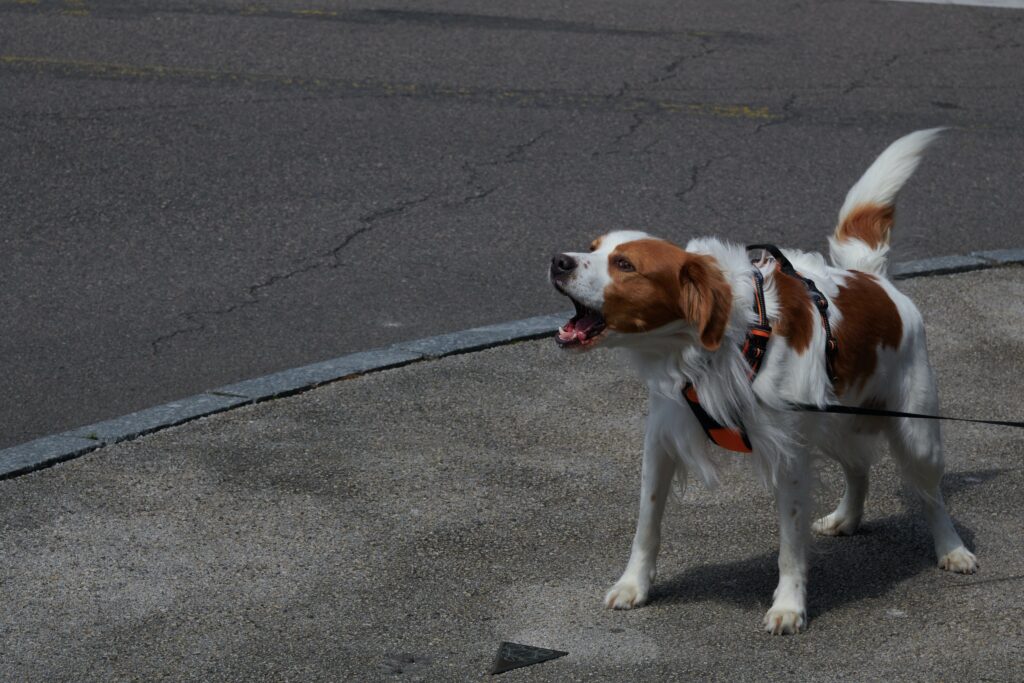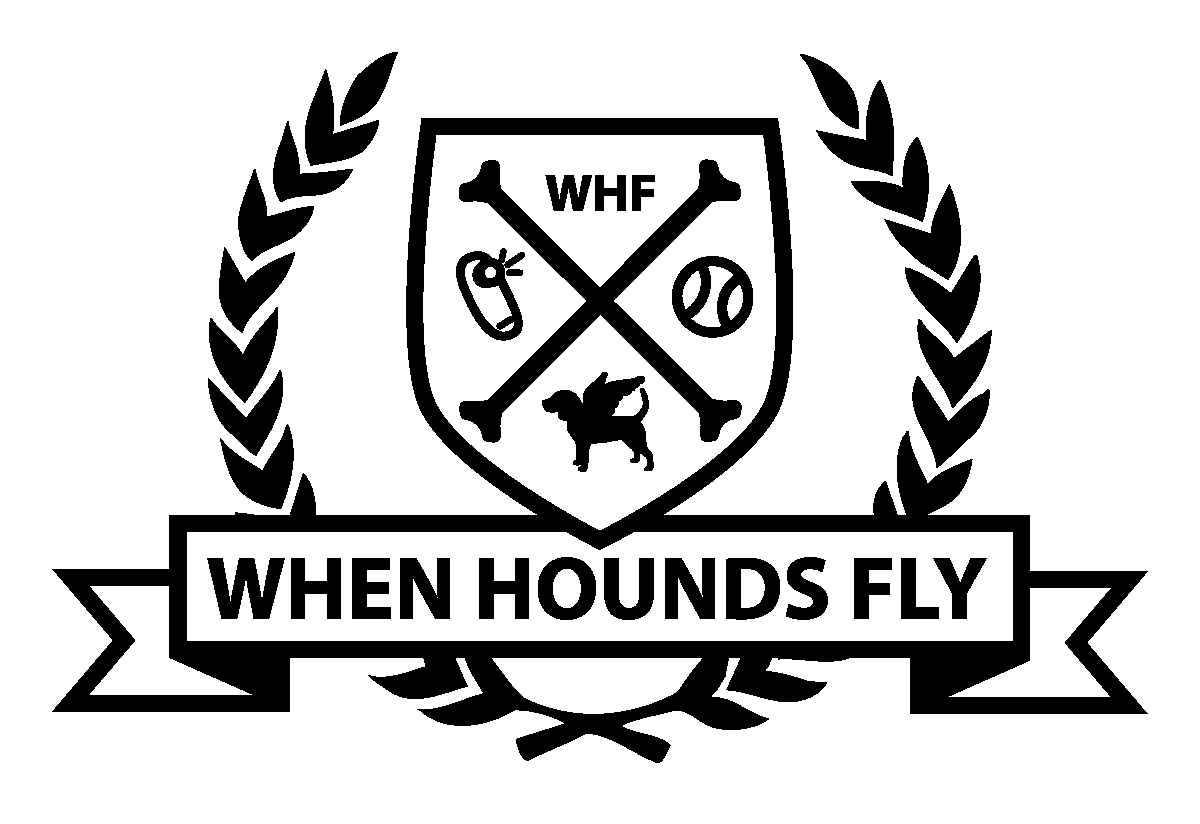By Rachael Johnston, KPA CTP
As someone who works a lot with dogs and humans in the context of private lessons I commonly hear this story from many a confused and exasperated client:
“My energetic puppy used to be friendly to all the dogs he met but now that he is a few months older he is becoming aggressive when we pass by or greet other dogs on leash. He growls, barks, lunges and pulls – it’s really embarrassing and quite stressful. The aggressive responses seem to be happening more over time and now I’m getting nervous when we pass or greet other dogs because I don’t know if my dog will be nice or if he will lunge, snarl and snap. What happened to my friendly puppy?”

Not uncommonly this story begins with a sweet and sociable puppy. This puppy is friendly and enthusiastic and wants to say hi to ALL the dogs he meets. It’s adorable to see him interact with other dogs and it’s “good socialization” so we follow our puppy as he drags us from one dog to the next to say hello. He was small and cute back then so most people didn’t mind him barging over to say hi to their dog.
As time went on of course our puppy grew much bigger and entered his adolescence phase. His desire to say hello to all the dogs in the neighbourhood is still high but now that he is so much bigger and more rambunctious people are less thrilled with his over the top greeting overtures! They are less welcoming of a large, over enthusiastic canine teenager jumping all over their dogs especially if they seem at all aggressive.
So we stop letting our dogs say hi to other dogs on leash as it is beginning to feel stressful, embarrassing and unmanageable.
However embarrassing and stressful it may be to us humans, it’s important to remember that we are not the only ones feeling big emotions during these moments. Our dogs are struggling too.
Let’s Switch Lenses for a Moment
How is our dog feeling?
From our dog’s perspective the rules have suddenly changed – He used to be able to say hi to lots of other dogs. Now he is experiencing increasing feelings of frustration as his opportunities to greet other dogs are becoming fewer and fewer. Each time he attempts to use his strength and enthusiasm to pull towards other dogs to greet them he is often met with an irritated owner scolding him and roughly pulling him away from a potential friend. Frustration grows and grows.
Before long our once friendly dog is finding himself repeatedly experiencing feelings of deep frustration each time he sees but cannot greet another dog and each time he is scolded or handled roughly by his exasperated humans after attempting to greet. These negative emotions continue to build until he now feels frustration the second he simply sees another dog and the result is:
Barking, lunging, snapping, snarling.
Through the Lens of Classical Conditioning:
While we are switching lenses it is important to take a moment to look through the scientific lens also to more clearly see what is going on in our dog’s brain while this reactivity is developing.
Most people will know exactly who I’m speaking of when I bring up the topic of Ivan Pavlov and his drooling dogs. Pavlov, of course, discovered the learning process of classical conditioning.
Pavlov’s experiments with dogs ran like this:
- Ring a bell (stimuli “one”) then immediately after the bell was rung
- Feed meat (stimuli “two”) to his canine test subjects.
The result of smelling / eating the meat was of course that the dogs would begin to drool (an involuntary bodily response).
What Pavlov came to discover (quite by accident in fact) was that: with repeated pairings of these two stimuli (bell then meat), he could condition the dogs to begin drooling upon the ringing of the bell alone. The bell itself now stimulated the part of their brain that activated the glands to produce saliva. It became a learned association.
Classical conditioning is also at the heart of the development of “frustrated greeter reactivity”. Just like with the bell and the meat we are pairing two things together repeatedly and creating a practiced pathway in our dog’s brain:
- Dog sees other dog (stimuli “one) then
- Dog is dragged away from a potential friend (stimuli “two”)
The result is: repeated episodes of our dogs feeling frustrated in the presence of other dogs in the context of leash walks.
Eventually we start to notice with dismay that the mere sight of dogs on walks is now becoming the automatic trigger for a flood of frustration and resulting reactivity.
An Ounce of Prevention
The good news is that if we are aware and proactive “frustrated greeter reactivity” is a problem that is largely avoidable!
Below are some key points on how to avoid this type of reactivity from developing in your young dog:
- Set Expectations Early – Greet some but not all dogs.
While it is just fine to give your puppy socialization opportunities in the form of on leash greetings it is also important to set expectations early in regards to who your puppy will greet and when. If this decision is dictated largely by your puppy he will reinforce himself time and again by dragging you around to greet as many other dogs as he can!! Then, when he gets older, if the rules suddenly change (you are no longer allowing him to have on leash greetings) it can be very confusing and very frustrating.
To avoid this trap: While your dog is still young choose to meet only a few dogs on your daily puppy outings rather than most. In the meantime also take the time to help your puppy practice passing dogs without a greeting.
Simply gain a bit of distance from the passing dog and reinforce (treat) your puppy for noticing the other dog at a distance without pulling in their direction. If they pull / act out you will likely need to gain a bit more distance next time. The goal is to have them learn that seeing dogs without greeting is a source of reinforcement too – reinforcement from you!
- Daily Enrichment – Fill your dogs emotional cup
To remain physically / emotionally healthy and balanced our dogs (at all stages of life) need a balance of quality exercise, mental stimulation, meaningful social opportunities, quality rest and quality nutrition. If our dogs are not getting these essential needs met somehow on a regular basis the result often is that they “act out” in over the top ways to make up for what they are missing.
This infographic explains the importance of daily enrichment for our dogs and how to help fill that cup each day!
- Foundation Training – Sign up for dog training classes!
While it is important to give your dog freedom to explore and interact with his world on a regular basis it is also essential that we balance that freedom by setting clear (and fair) boundaries early on. We set these boundaries by teaching our dogs how we would like them to conduct themselves in the world. This learning should start as early as possible (at age 8 to 10 weeks) and should continue throughout your dog’s adolescent phase.
Like it or not, if we don’t take the time to teach our dogs how we would like them to behave in the world you can bet they will make their own choices about how to get their daily needs met!!! This commonly leads to the emergence of “nuisance behaviours” and “impulse control challenges” i.e. demand barking for attention, dragging their humans around for greetings or to get to the park faster, jumping all over guests etc…. These dogs have a harder time controlling their impulses and remaining patient when needed because they haven’t been taught how.
It is our job to help our dogs learn the behaviours we would like to see instead such as: going to their mat to wait for dinner, walking with slack in the leash, easily dropping items when asked, checking in with their humans to ask to greet other dogs etc. These dogs learn the value of patience and thoughtful problem solving and are much more enjoyable companions.
What if my dog is already showing signs of “frustrated greeter reactivity”?
You may be in the position where your dog has already developed frustrated greeter reactivity and you are now struggling with how to resolve this challenge. More good news! This is a challenge that has a high resolution success rate so long as we are knowledgeable in how to help our dogs work through it.
For more guidance on helping your dog overcome their reactivity challenges check out this article:
“The Secret to Treating your Dog’s Reactivity”
Additionally we can assist you through our highly effective Reactive Dog Group Class program! This 7 week, hands on course will guide you through the theory and the physical mechanics of helping your dog work through their reactivity so you can enjoy peaceful leash walks together once again.
